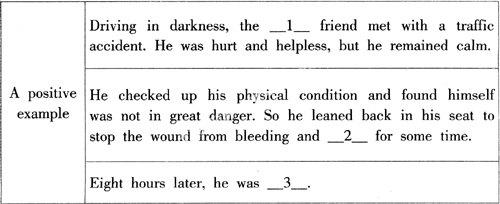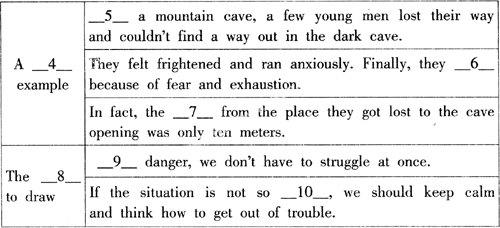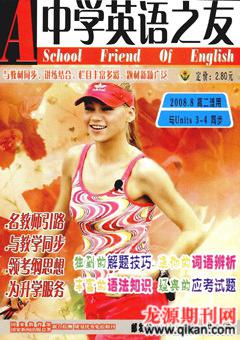高中二册第3单元练习
曹 洁
第一部分: 听力略(共30分)
第二部分: 英语知识运用
Ⅰ.单项选择(每小题1分,满分15分)
1. Food is to man ____ oil is to a machine, which is really very
reasonable.
A. as B. what C. that D. where
2. Lets ____ the problem for the moment and learn a new lesson, shall we?
A. set away B. throw away C. throw off D. give up
3. Your youngest brother always tries to find faults with me; I cant stand ____ with him.
A. to work B. worked C. working D. work
4. During my stay in Beijing with her, her kindness and honesty ____ me deeply and Ill never forget her.
A. hit B. beat C. knocked D. impressed
5. That day we sang an old folk song together, which ____ me of my sweet childhood.
A. informed B. reminded C. told D. remembered
6. When you make any important decision, I think that you should first ____ peoples interest.
A. look at B. look for C. look after D. look through
7. Can you tell me whom this English-Chinese dictionary ____ to? It must be returned to its owner as soon as possible.
A. is belonged B. belongs
C. is belonging D. is being belonged
8. ____ the sudden change of whether, we still managed to finish our task according to the original plan.
A. Despite B. Though C. Although D. While
9. He lives near a railway station, so it is ____ for him to take a train whenever he wants to.
A. free B. convenient C. lawful D. right
10. If you go shopping, you can buy some food and oil. ____, you can also buy some reference books.
A. Besides B. Whats worse C. Or rather D. For example
11. This kind of food ____ good, so Im sure that you will enjoy eating it very much.
A. tastes B. is tasted
C. is tasting D. is being tasted
12. Just at that time, I found a middle-aged woman ____ on the ground.
A. sit B. sat C. sitting D. to sit
13. You must hurry up, because there are only five minutes ____.
A. leave B. leaving C. left D. to leave
14. As far as I know, this terrible war happened ____.
A. in the 1940 B. in the 1940s C. in 1940 D. in 1940s
15. The woman is always very busy doing housework ____ her husband has nothing to do all day.
A. while B. when C. as D. instead
Ⅱ.完形填空(每小题1.5分,满分30分)
Many people who work in London prefer to live outside it, and to go to their offices, factories or schools every day by train, car or bus, even though this __1__ they have to get up earlier in the morning and reach __2__ later in the evening.
One benefit of living outside London is that houses are __3__. Even a small flat in London without a garden costs quite a lot to __4__. With the same money, one can get a little house in the country with a garden of ones own.
Then, in the country one can be __5__ from the noise and hurry of the town. __6__ one has to get up earlier and spend more time in trains or buses, one can sleep __7__ at night, and, during weekends and __8__ summer evenings, one can enjoy the __9__ clean air of the country. If one likes gardens, one can spend ones __10__ time digging, planting, watering and doing a hundred and one other __11__ which are needed in the garden. Then, when the flowers and vegetables come __12__, one has the reward(报偿) of a person __13__ has shared the secrets of __14__.
Some people, however, take __15__ interest in country things; for them, happiness __16__ in the town, with its cinemas and theatres, beautiful shops and busy streets, dance-halls and restaurants. __17__ people would feel that their life was not __18__ living if they had to live __19__ outside London. A walk in one of the parks and a visit to the sea every summer is all that they __20__.
1. A. shows B. expresses C. means D. requires
2. A. home B. flat C. house D. family
3. A. cleaner B. nicer C. bigger D. cheaper
4. A. live B. lend C. borrow D. hire
5. A. free B. far C. out D. quiet
6. A. Because B. Although C. After D. If
7. A. little B. less C. longer D. better
8. A. on B. for C. by D. at
9. A. cold B. warm C. fresh D. pleasant
10. A. rest B. day C. spare D. whole
11. A. repairs B. tools C. people D. jobs
12. A. on B. to C. up D. over
13. A. who B. whom C. whose D. which
14. A. society B. mankind C. science D. nature
15. A. no B. much C. more D. great
16. A. lays B. lies C. happens D. appears
17. A. But B. Such C. And D. Few
18. A. poor B. comfortable C. worth D. worthy
19. A. it B. life C. this D. that
20. A. hope B. wish C. ask D. want
Ⅲ.阅读理解(每小题2分,满分30分)
(A)
Buildings that reach for the skies may be seen in most of the worlds largest cities today. Ever since the first skyscraper was built in Chicago in 1883, more and more tall buildings have been constructed in more and more cities.
For many years the Empire State Building in New York City was the tallest building in the world. It was 1,250 feet high when it was opened in 1931. Then in 1951 a TV transmission tower was added for radio and television broadcasting. This tower added 22 feet to its height.
Soon it will be topped by other skyscrapers now being built. The World Trade Center in New York will be 1,350 feet high. Now being built in Chicago, the Sears, Roebuck and Co. office building will rise to 1,450 feet when it is completed. No one can say how many higher skyscrapers will be built in the future.
Early skyscrapers were built with thick, heavy walls of solid brick or stone or concrete. Now the new skyscrapers are being built with a steel framework that supports the weight of the building. This takes the place of the old solid walls and makes it possible to build to greater heights. The idea came mostly from engineers who were able to see a skyscraper framework as a kind of steel bridge set on end. Like the bridge, too, it would be light but strong and could be extended if necessary.
Built at first for house offices and shops, some skyscrapers are now becoming homes for people who want to live in the center of the city. “Big John”, a Chicago skyscraper that opened in 1970, is an example. “Big John” is the popular name of the 100-storey John Hancock Center. Between the first and the 43rd floor, there are offices and shops. Theres a swimming pool on the 44th floor. From the 45th floor to the 92nd, there are apartments. The people who live in these apartments can look down on the clouds instead of up at them. Every window has a beautiful view.
1. What was the tallest building in the world from 1931 to 1951? ____.
A. TV transmission tower
B. Empire State Building
C. The Sears, Roebuck & Co. office building
D. Big John
2. What are the new skyscrapers being built of? ____.
A. Solid brick B. Concrete
C. Steel framework D. Both A and B
3. What were the older skyscrapers built for? ____.
A. Offices and shops B. Offices and houses
C. Shops and homes D. Homes and offices
4. Which of the following is true? ____.
A. Empire State Building is the highest skyscraper in the world
B. “Big John” is a skyscraper built for house offices and shops
C. Many people seem to like living high above the city
D. There is a TV transmission tower on the top of the Empire State Building
5. Why did the engineers use steel framework to replace solid walls? ____.
A. Because the steel framework can add weight to a skyscraper
B. Because steel framework makes it possible to build new sky- scrapers to greater heights
C. Because using steel framework is a new technical method
D. Because inhabitants like to live in a skyscraper with a steel framework
(B)
The flag, the most common symbol(象征) of a nation in the modern world, is also one of the most ancient. With a clear symbolic meaning,the flag in the traditional form is still used today to mark buildings,ships and other vehicles related to a country.
The national flag as we know it today is in no way a primitive(原始的) artifact. It is, rather, the product of thousands of years development. Historians believe that it had two major ancestors, of which the earlier served to show wind direction.
Early human beings used very fragile houses and boats. Often strong winds would tear roofs from houses or cause high waves that endangered travelers. Peoples food supplies were similarly vulnerable. Even after they had learned how to plant grains, they still needed help from nature to ensure good harvests. Therefore they feared and depended on the power of the wind, which could bring warmth from one direction and cold from another.
Using a simple piece of cloth tied to the top of a post to tell the direction of the wind was more dependable than earlier methods, such as watching the rising of smoke from a fire. The connection of the flag with heavenly power was therefore reasonable. Early human societies began to fix long pieces of cloth to the tops of totems(图腾) before carrying them into battle. They believed that the power of the wind would be added to the good wishes of the gods and ancestors represented by the totems themselves.
These flags developed very slowly into modern flags. The first known flag of a nation or a ruler was unmarked: The king of China around 1000 B.C. was known to have a white flag carried ahead of him.This practice might have been learned from Egyptians even further in the past, but it was from China that it spread over trade routes through India, then across Arab lands, and finally to Europe, where it met up with the other ancestor of the national flag.
1. The best title for the passage would be ____.
A. Development of the National Flag
B. Power of the National Flag
C. Types of Flags
D. Uses of Flags
2. The underlined word “vulnerable” in Paragraph 3 means ____.
A. impossible to make sure of B. likely to be protected
C. easy to damage D. difficult to find
3. The earliest flags were connected with heavenly power because ____.
A. they could tell wind direction
B. they could bring good luck to fighters
C. they were handed down by the ancestors
D. they were believed to stand for natural forces
4. What will the author most probably talk about next? ____.
A. The role of China in the spread of the national flag
B. The second ancestor of the national flag
C. The use of modern flags in Europe
D. The importance of modern flags
5. What does the author know of the first national flag? ____.
A. He knows when it was sent to Europe
B. He believes it was made in Egypt
C. He thinks it came from China
D. He doubts where it starts
(C)
What makes a person a scientist? Does he have ways or tools of learning that are different from those of others? The answer is “no”. It is not the tools that the scientist uses but how he uses these tools that makes him a scientist. You will probably agree that knowing how to use a power saw is important to a carpenter. You will probably agree, too, that knowing how to investigate, how to discover information, is important to everyone. The scientist, however, goes one step further. He must be sure that he has a reasonable answer to his question and that his answer can be confirmed(证实) by other persons. He also works to fit the answers he gets to many questions into a large set of ideas about how the world works.
The scientists knowledge must be exact. There is no room for half right or right just half the time. He must be as nearly right as the conditions permit. What works under one set of conditions at one time must work under the same conditions at other times. If the conditions are different, any changes the scientist observes in a demonstration(说明) must be explained by the changes in the conditions. This is one reason that investigations(调查) are important in science. Albert Einstein, who developed the Theory of Relativity, arrived at this theory through mathematics. The accuracy(精确) of his mathematics was later tested through investigations. Einsteins ideas were shown to be correct. A scientist uses many tools for measurement. Then the measurements are used to make mathematical calculations that may test his investigations.
1. What makes a scientist according to the passage? ____.
A. The tools a scientist uses
B. His ways of learning
C. The way a scientist uses his tools
D. The different tools
2. What can we learn from the passage? ____.
A. The scientists knowledge is always right under all conditions
B. When the condition changes, the result of the observation may also change
C. Condition makes no difference to scientists
D. Theres no point for ordinary people knowing how to investigate
3. “The scientist, however, goes one step further, …” the author says this to show ____.
A. the importance of information
B. the importance of thinking
C. the difference between scientists and ordinary people
D. the difference between carpenters and people with other jobs
4. A scientific theory should be one that ____.
A. not only works under one set of conditions at one time, but also works under the same conditions at other times
B. leaves no room for improvement
C. does not allow any changes even under different conditions
D. can be used for many purposes
5. What is the main idea of the passage? ____.
A. Scientists are different from ordinary people
B. The Theory of Relativity
C. Exactness is the center of science
D. Exactness and way of using tools are the keys to the making of a scientist
Ⅳ.阅读填词(每小题1分,满分10分)
To Survive from Danger, to Keep Calm
A friend of mine met with an accident driving in darkness. His legs were so hurt that he couldnt move. What was the worst was that he found himself unable to ask for help—his mobile phone went out of work. Nothing could be done but to wait in cold wilderness. 8 hours later, day broke, and then the rescue arrived.
It is almost unimaginable that he could stand the horror in the darkness for so long. Even more surprising was his explanation: “First of all I checked up my physical conditions and found myself not in fatal danger. As there was no way to call for help, I leaned back in my seat trying my best to keep the wound from bleeding. In this way I dozed (打盹) off.”
His story put an end to my regret for the failure of an exploration adventure that happened last year. A group of young men tried to explore a mountain cave and got lost. Unable to find a way out in the dark cave, they were frightened and ran anxiously without a sense of direction. Finally they fell dead in fear and exhaustion. The place where they got lost was only about 10 meters away from the opening of the cave! If they tried to calm themselves, they would probably sense a faint light shining not far away.
Dont you think that you can compare it with life itself? When you meet with obstacles(障碍) in life and work, you are lost in darkness. Mind you its unclear yet and you neednt put up struggle immediately. But a person who can afford to do so must have foresight as well as a great courage.


Ⅴ.短文改错(每小题1分,满分10分)
Most of large cities in the world have grown 1.____
without plans, in which London is a such one. 2.____
Londons streets wind its way and there is no reason3.____
or order to it street numbering system. Indeed no 4.____
one but a practical taxi driver knows the whole of 5.____
London. And after he gets his license, he must 6.____
first tour the city for months, street by the street, then7.____
take a test to prove that he can find his way about.8.____
New York and Chicago grew in much the same. They9.____
spread out like pouring water expanding at all directions.10.____
Ⅵ.书面表达(满分25分)
根据下面的文字提示,以“Should Old Buildings Be Kept Or Not?”为题,写一篇短文,词数120左右。提示如下:
观点1:北京的古老西式建筑应该保留
原因:(1)这些古建筑是由不同国家,不同时代的建筑师设计、修建的,它们风格各异,有利于我们学习、鉴赏;(2)这些古建筑具有历史价值和审美价值;(3)这些古建筑是历史的见证,警示我们勿忘国耻。
观点2:北京的古老西式建筑不应该保留
原因:(1)这些古建筑是由不同国家、不同时代的建筑师设计、修建的,它们的风格不统一,不能体现时代气息;(2)这些古建筑看起来不协调;(3)这些古建筑占用了太多的面积和空间。
Key(2)

